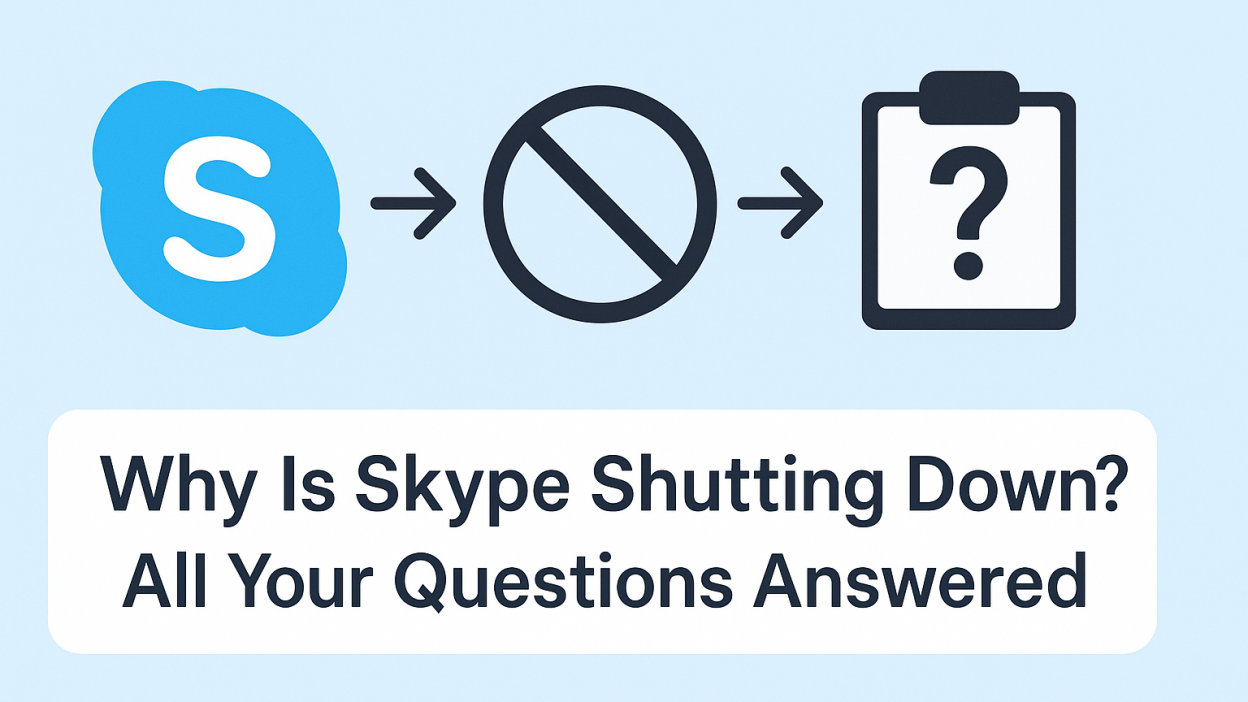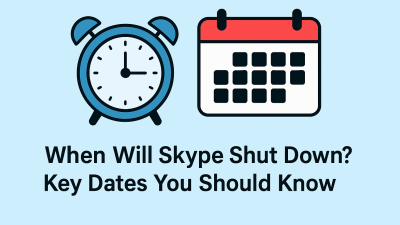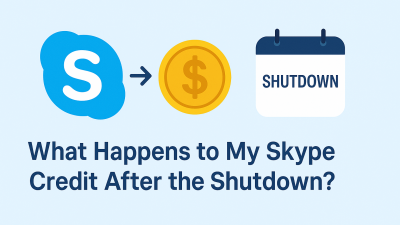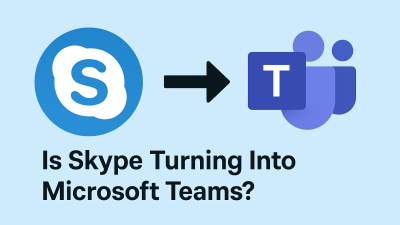For years, Skype was more than just an app. It was a lifeline. It’s how families stayed close across continents, how freelancers found their footing, and how countless people made their first international call. It was reliable, simple, and for a long time, it was unmatched.
So when Microsoft confirmed it would permanently shut down Skype on May 5, 2025, it didn’t feel like just another software update; it felt like losing a part of digital history.
Maybe you’re reading this because you saw the headline and thought, “Wait, really?” Maybe you haven’t used Skype in a while, but it’s still installed, just in case. Or maybe you’re still using it regularly, to call overseas, message clients, or check in with your parents back home.
Wherever you are on that spectrum, this post will walk you through why Skype is being retired, what happens next, and what options you have now.
So, Why Is Skype Really Shutting Down?
The official explanation from Microsoft is simple: they’re “streamlining communication services.” But what does that actually mean?
It means Microsoft is focusing all its energy and resources on Microsoft Teams, the app it now considers the future of communication, not just for work, but for everyday users too. Teams is where Microsoft wants everyone to be. And maintaining two separate apps that do almost the same thing? That no longer fits their plan.
Teams can do pretty much everything Skype did, chat, voice calls, video calls, but it’s also built to handle more complex needs. It works better across devices, connects to the whole Microsoft 365 ecosystem, and updates more frequently.
Skype, by contrast, was built on older technology. Over the years, it became harder to update, harder to integrate, and eventually, easier to phase out than rebuild from scratch.
This isn’t just a case of moving on. It’s about shifting to a platform that can evolve more easily, one that already has the infrastructure to serve today’s fast-moving communication needs.
Skype’s Decline Didn’t Happen Overnight
If you’re wondering why Skype couldn’t just keep going as-is, you’re not alone. The truth is, Skype’s fall wasn’t sudden. It was gradual, and it happened in plain sight.
At one point, Skype was the name in video calling. It had a global user base, brand recognition, and a massive lead over competitors. But something changed.
Other platforms — Zoom, Google Meet, FaceTime, WhatsApp- started doing what Skype did, and often did it faster, cleaner, and more mobile-friendly. Skype missed key opportunities to evolve during the shift to mobile-first communication. And during the pandemic, when everyone was suddenly relying on video calls, Skype should’ve been the hero. Instead, Zoom dominated, Teams exploded, and Skype barely kept up.
It’s not that Skype became bad. It just stopped being the best option. Slowly, people moved on — and Microsoft did too.
Microsoft Teams Took the Lead (Even If You Didn’t Notice)
You might think Teams is only for businesses, for people with corporate emails and endless meetings. That was true once, but it’s changed.
Over the past few years, Microsoft has expanded Teams Free, a version built for personal use. It works for chatting with friends, calling family, and even planning events or running small businesses. It’s not just a workplace tool anymore — it’s the platform Microsoft hopes everyone will use moving forward.
From Microsoft’s perspective, it doesn’t make sense to keep building and supporting two apps that do the same thing. Teams is newer, faster, more scalable, and already used by millions. Skype had a great run, but in their ecosystem, it simply became the older sibling who stayed home while the rest of the family moved forward.
So instead of keeping Skype on life support, Microsoft is inviting users, gently but firmly, to migrate.
What Happens to Skype After May 2025?
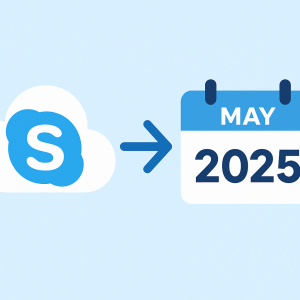
On May 5, 2025, Skype will officially shut down for both free and paid users. That includes:
-
The desktop and mobile apps
-
Skype for Web
-
Any in-app purchasing (like call credit or subscriptions)
If you’re still using Skype, you’ll start receiving notifications prompting you to switch to Teams. These reminders are built into the app and will become more frequent as the shutdown date gets closer.
Microsoft has said that users who log in to Teams Free using their Skype credentials will be able to retain contacts and some recent chats. But anything else, files, older messages, call logs, may not transfer automatically. Those will need to be saved manually.
Paid services are also ending. If you had a Skype subscription for international calls or Skype Number features, those will expire. In some cases, Microsoft may refund unused credit or apply it to your Microsoft account. But after May, those services won’t be available anymore, even if you still have minutes left.
It’s not a soft phase-out. It’s a final curtain.
Still Using Skype for International Calls? You Have Other Options
Not everyone used Skype for chats and meetings. For many people, Skype was a simple, affordable way to make international calls, without asking the person on the other end to install anything.
That experience is getting harder to find. Microsoft Teams does support calling, and there’s even a dial pad for some users, but it’s not really designed for that one-click, no-frills calling experience that Skype offered.
If that’s the feature you’re most worried about losing, you don’t have to settle for Teams. There are still tools out there built for just international calling, and they’re worth exploring.
In the next section, we’ll walk through the most realistic alternatives, how they compare, and which ones actually respect the simplicity Skype users are used to.
What Should Skype Users Do Now?
If you’re still using Skype — even occasionally — now is the time to take action. The shutdown in May 2025 isn’t just symbolic. It will affect your access, your conversations, your contacts, and any credit or paid features tied to your account.
Start by signing in to Microsoft Teams Free using the same email you used for Skype. Microsoft has designed Teams to pull in your Skype data automatically. You won’t need to create a new profile or migrate data manually in most cases.
But don’t assume everything will come over cleanly. If you have important conversations saved in Skype or if you use it for business, exporting your chat history is a smart backup move. Microsoft offers a simple way to request your data, including messages and shared files, through their Skype Export Tool. It usually takes just a few minutes to generate.
Also, check your Skype credit balance. If you have leftover credit, you’ll either want to use it up before May or request a refund. Microsoft has stated they’ll support refunds for unused credit in most regions, but you’ll need to act before the shutdown date.
Taking these small steps now saves you from a last-minute scramble when the app is suddenly unavailable.
What if You Don’t Want to Use Microsoft Teams?
Not everyone will feel at home in Teams, and that’s okay.
Some users have already tried Teams and found it too heavy for what they need. If your goal is to simply message friends, make personal calls, or run small informal group chats, Teams might feel more complex than it needs to be.
Teams is packed with features: channels, meeting schedulers, app integrations, file sharing, all great if you need them, but overwhelming if you don’t. If all you want is a lightweight, Skype-style experience, you don’t have to settle for something bloated.
There are tools out there that do one thing, and do it well.
The Best Skype Alternatives in 2025 Based on What You Actually Use
If You Used Skype for Video Calls with Family or Friends
Apps like WhatsApp, Google Meet, and FaceTime have filled that role for millions of people. They’re intuitive, fast, and usually come pre-installed on your phone or computer. All of them support high-quality video calls, group chats, and quick voice messages.
If your circle of contacts already uses one of these platforms, switching over is practically seamless. You don’t even need to think about usernames, just tap a contact and go.
If You Used Skype for Work-Related Messaging or Calls
In this case, Microsoft Teams still might be your best option. It’s designed for people who need to manage communication across projects, clients, or internal teams. If you already use Microsoft 365 apps like Word, Excel, or Outlook, Teams integrates tightly with those, making it easier to keep everything in one place.
Another solid option is Slack, especially if your communication style is more message-driven than meeting-heavy. Slack is built for fast, threaded conversations, with fewer moving parts than Teams.
If You Use Skype for Low-Cost International Calling

This is where most Skype alternatives fall short; they’re great at video or chat, but not built for calling landlines or mobile numbers overseas. If this is what you’re losing with Skype, you’ll want a tool that focuses on just that.
One to seriously consider is MyTello. It’s specifically designed for international calls, has no contracts, no software to install, and no need for the person on the other end to use the same app. You just dial, connect, and pay by the minute (with rates often cheaper than Skype).
What makes MyTello stand out is that it works with any regular phone number. That means you can keep calling grandma’s landline in India, or your old flatmate’s cell in the UK, without asking them to download anything or figure out a new app.
For users who relied on Skype’s simplicity and flexibility for international calls, MyTello feels like a continuation, not a compromise.
Will Anything Replace Skype Exactly?
It’s a fair question. Skype had a unique mix of casual and professional. You could use it to chat with your cousin or to interview a new hire. It sat right between personal and business use in a way few apps have pulled off since.
Most modern tools now lean hard in one direction or the other: either they’re polished for enterprise (like Teams), or stripped down for casual use (like WhatsApp). So no, there isn’t a perfect 1:1 replacement. But that doesn’t mean you’re stuck.
The key is matching the tool to your real needs:
-
Want simplicity and ease of use? Stick with messaging apps that do one thing well.
-
Need advanced features and full account control? Use Teams or Slack.
-
Still calling landlines or people without smartphones? Choose services like MyTello that are built for that job.
Once you know what you’re actually looking for, choosing becomes easier, and you’re not just trying to force a Skype-shaped memory into a Teams-shaped box.
What About Skype for Business? Wasn’t That Different?
Yes — and it already shut down. Skype for Business Online was retired in July 2021, and all enterprise-level users were pushed toward Microsoft Teams. What’s happening now is the final stage: shutting down the consumer version of Skype as well.
This is a full exit, not a rebrand or a relaunch. Whether you used Skype casually or for work, it’s being phased out entirely.
Questions People Are Still Asking
There’s been a lot of confusion online, so let’s clear up a few common questions:
Is Skype really shutting down for everyone?
Yes — free and paid users, business and personal. May 5, 2025, is the official end.
Will I lose my contacts and chat history?
If you sign into Teams with your Skype account, some recent contacts and chats will carry over. Anything older should be exported manually.
What if I don’t want to use Teams?
You’re free to use any other platform that meets your needs — Microsoft is encouraging Teams, but it’s not mandatory.
Can I keep my Skype Number or call credit?
Credit may be refundable if unused, but Skype Numbers and paid services will expire. Microsoft has not announced any long-term plans for those features.
Is Teams free?
Yes. Teams has a free version for personal use. You don’t need to pay to keep chatting or calling basic contacts.
A Farewell, But Not a Dead End
Skype meant something. It connected people before the world was used to being connected. And while it didn’t keep up with the competition, its legacy shaped how we communicate today.
Saying goodbye doesn’t mean giving up on what Skype gave us. It means taking the time to find what still works, what fits your life now.
So whether you’re moving to Teams, switching to something lighter, or choosing a call-first tool like MyTello, make the move on your terms. Save what matters. Stay connected. And don’t wait until the app just stops working to figure out what’s next.

